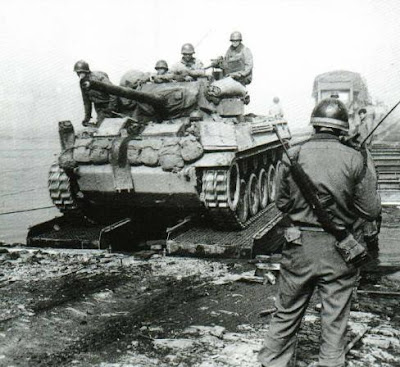The M18 Hellcat was a gun motor carriage used by the US Army in WW2 and the Korean War. To fulfill the anti-tank role, it was fitted with a 76.2-mm (3-in) M1A1 gun, which had been developed for the M10 vehicle. Its main attribute was its speed, as it could run in excess of 55 mph sustained speed. It was possible due to its light weight of 18 tons and its powerful Continental R-975 C-4 engine, which delivered 460 horsepower, making it the fastest tank destroyer and armored vehicle fielded in World War II.
Being introduced into service in 1943, the M18 Hellcat first saw combat action during the Battle of Anzio, in Italy in January 1944. It also took part in the Battle of Normandy in June and July 1944. It played an important role in the Battle of the Bulge in December 1944, as part of the US Army's 10th Armored Division. This tank destroyer was also employed in the Pacific Theater of Operation, providing the US Army units with fire support on Okinawa Island and in the Philippines. During this armed conflict, it proved to be very effective, capable of tackling all types of German, Italians, and Japanese tanks, except for the Panzer VI Tiger and Panzer V Panther.
Technical Description
The M18 Hellcat was entirely designed from the outset to carry out the mission of tank hunting. Its hull was made of individual armor plates welded together. The driver's compartment was in the front and it had two seats, with the driver on the left and his assistant on the right. The fighting compartment was located in the center of vehicle, while the engine was in the rear compartment. The turret was a welded unit, mounting the 76-mm gun. It was also armed with a .50-caliber (12.7-mm) Browning machine gun, which was mounted on a ring which was built into the turret itself.
The Continental R-975 C-4 that drove the M18 was a radial engine. It was literally a round engine, which ran on gasoline. It was air cooled by a fan attached to the fly-wheel, clutch, and pressure plate. A shroud surrounded the finned cylinders and heads. The starter, magneto, and carburetor were in the center of the engine. A transfer case was employed to direct the power down and forward through a driveshaft to the differential in front. A second transfer case directed the power up to the Torqmatic transmission in the front.
Specifications
Type: tank destroyer
Armament: one 76.2-mm (3 inches) anti-tank gun; one .50-caliber machine gun.
Weight: 18 tons
Length of Hull: 5.44 m (17 feet, 10 inches)
Length Overall: 6.65 m (21 feet, 10 inches)
Width: 2.87 m (9 feet, 5 inches)
Height: 2.58 m (8 feet, 5.5 inches)
Power Plant: one 460-HP, Continental R-975 C-4 gasoline engine.
Maximum Speed: 55+ mph (88 km/h) on road
Range: 105 miles (169 km)
Gradient: 60 per cent.
Below, the M18 Hellcat in a military museum in Virginia.
The side and rear view of the tank destroyer.
A M18 Hellcat of the 4th Armor Division, crossing the Moselle River, in northeastern France in September 1944.






No comments